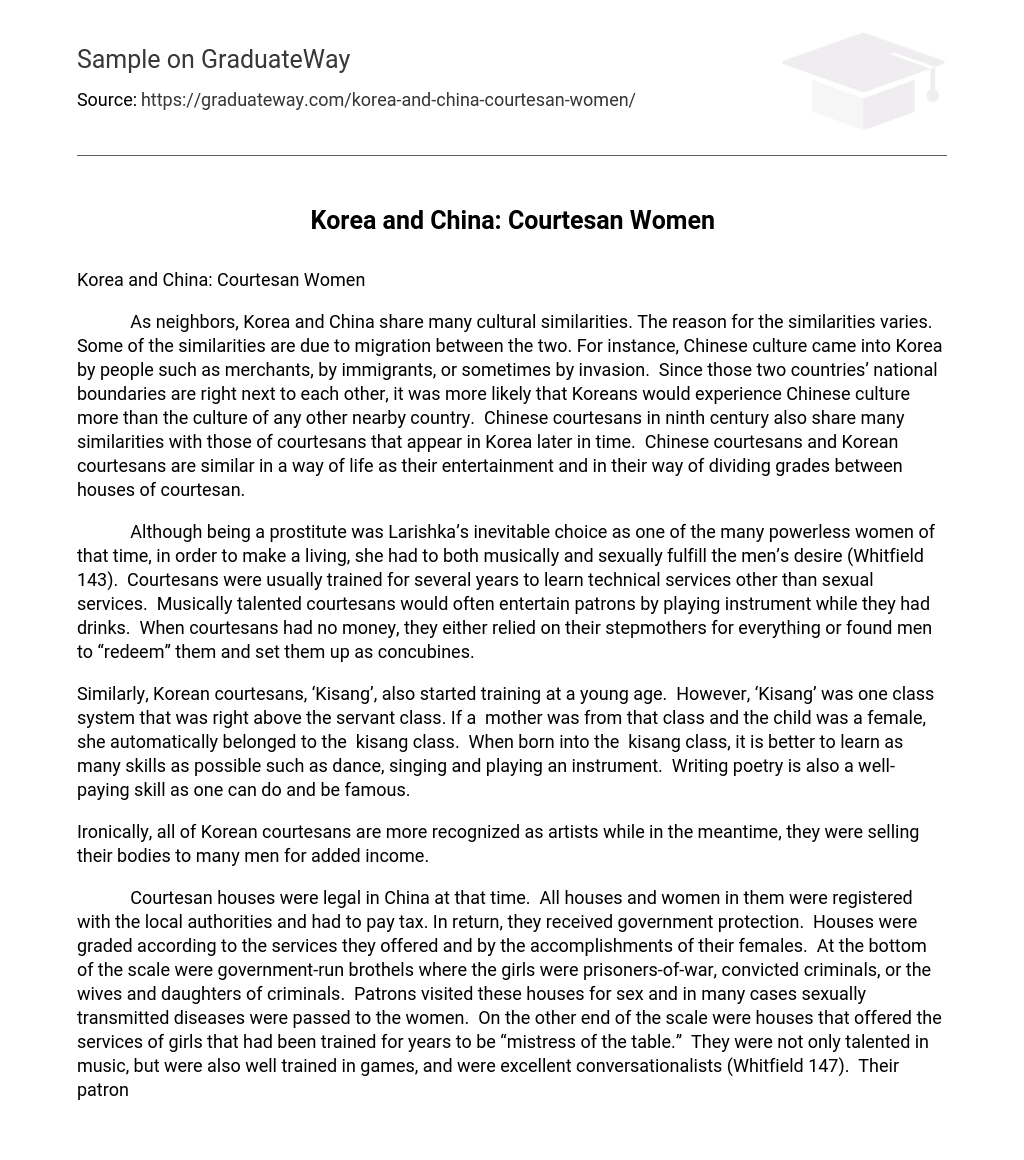As neighbors, Korea and China share many cultural similarities. The reason for the similarities varies. Some of the similarities are due to migration between the two. For instance, Chinese culture came into Korea by people such as merchants, by immigrants, or sometimes by invasion. Since those two countries’ national boundaries are right next to each other, it was more likely that Koreans would experience Chinese culture more than the culture of any other nearby country. Chinese courtesans in ninth century also share many similarities with those of courtesans that appear in Korea later in time. Chinese courtesans and Korean courtesans are similar in a way of life as their entertainment and in their way of dividing grades between houses of courtesan.
Although being a prostitute was Larishka’s inevitable choice as one of the many powerless women of that time, in order to make a living, she had to both musically and sexually fulfill the men’s desire (Whitfield 143). Courtesans were usually trained for several years to learn technical services other than sexual services. Musically talented courtesans would often entertain patrons by playing instrument while they had drinks. When courtesans had no money, they either relied on their stepmothers for everything or found men to “redeem” them and set them up as concubines.
Similarly, Korean courtesans, ‘Kisang’, also started training at a young age. However, ‘Kisang’ was one class system that was right above the servant class. If a mother was from that class and the child was a female, she automatically belonged to the kisang class. When born into the kisang class, it is better to learn as many skills as possible such as dance, singing and playing an instrument. Writing poetry is also a well-paying skill as one can do and be famous.
Ironically, all of Korean courtesans are more recognized as artists while in the meantime, they were selling their bodies to many men for added income.
Courtesan houses were legal in China at that time. All houses and women in them were registered with the local authorities and had to pay tax. In return, they received government protection. Houses were graded according to the services they offered and by the accomplishments of their females. At the bottom of the scale were government-run brothels where the girls were prisoners-of-war, convicted criminals, or the wives and daughters of criminals. Patrons visited these houses for sex and in many cases sexually transmitted diseases were passed to the women. On the other end of the scale were houses that offered the services of girls that had been trained for years to be “mistress of the table.” They were not only talented in music, but were also well trained in games, and were excellent conversationalists (Whitfield 147). Their patrons often hired the girls as companions to banquets and expect them to drink along with them. The best among best courtesans were girls who were skilled at composing poetry. They were in an ideal situation where they were paid for their talent rather than sexual skills.
Although in recent times, prostitution is illegal in Korea, it has only been illegal for a few decades. Korean courtesan houses were also divided into different levels but their standard way of dividing was different from China’s way. Since Korean courtesans are born with certain class, people cannot become courtesans even if they want to. However, courtesan houses in Korea were more likely to divide by the appearance of their females and their ability to entertain and please patrons.
For example, Jinlee Huang from the Chosun period was considered to be the best kisang from Korea. She was not only the most beautiful kisang that Korea had, but also the most skilled musician and poet. She was also known for never having sexual relations with anyone but her lover. Without having a business based on her sexual talent, Jinlee Huang gave pleasure to patrons by her immense beauty and her vast array of talents.
Although a courtesan’s life in nineteenth century Korea and China may be viewed as somewhat desperate or bleak, the point that one must realize is that was the life of a female at the time. They were desperate and life was a little bleak for them. While prostitution now is often deemed disgusting and for only women of the lowest moral value among many, it must be understood that there are more job opportunities for women, now. In nineteenth century Korea and China, being a courtesan provided income for those who really needed it.
Women such as Jinlee Hauang encouraged other Korean women to not only focus on the easy money that the sexual job opportunities brought, but rather to focus on their other talents. These women made the minds of beautiful women become as interesting or almost as interesting as their bodies. That paved a better future for generations to come.





